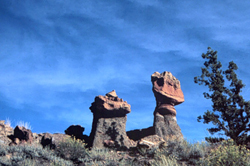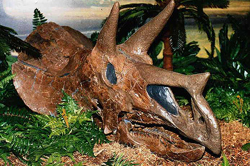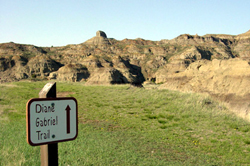Makoshika State Park

Makoshika State Park is the largest State Park in Montana. It encompasses 11,531 acres at an elevation of 2,069 feet. The name is a variant spelling of the Lakota phrase meaning bad land or bad spirits. Today the badlands of Makoshika are set aside for visitors to see and enjoy.
Geology and Dinosaurs

Makoshika State Park, in eastern Montana, is full of beautiful rock formations. The name Makoshika is a Lakota (native American) word that, roughly translated, means "badlands". Some archeologist think that people have lived in the area for 12,000 years or more. When European settlers came to the area in the 1800, they called the place "hell without the fire" because the stark beauty of the place impressed them.
It began as a tropical sea in prehistoric times. Many layers of mud built up on the bottom of the sea, and in the mud were the decayed remains of plants and animals. Eventually, more layers of mud buried the first layers, until the earlier layers were under tremendous pressure. This process continued, layer upon layer, until millions of years later, the mud petrified into stone. Then approximately 65 million years ago, the area that is now Makoshika was a flood plain. The Yellowstone River and the streams that flow into it cut deeply into the rock, exposing colorful bands of stone. The water eroded the stone away in places, producing fascinating formations. Caprocks, spires, hoodoos, hogback ridges, fluted hillsides, pinnacles, mesas, and buttes are types of rock formations seen at Makoshika.
Makoshika State Park has a wealth of fossils. Remains from ten different kinds of dinosaurs and many other plants and animals are found in the park. Fossils can give scientists valuable clues about how old a layer of rock is. Of the ten species of dinosaur found at Makoshika Park, three are very well known. They are Triceratops, Edmontosaurus, and Tyrannosaurus Rex. There is the skull of a Triceratops in the visitor center, and other interesting fossils are on display. The visitor center also has fascinating films that explain the geological history of the region.

Botany, Hiking, and Bird Watching
Makoshika State Park offers visitors the opportunity to identify trees, flowers, and other plants. There are about 100 different kinds of wildflowers in the park, as well as Rocky Mountain juniper, rabbitbrush, sagebrush-grassland, yucca, cottonwood, willows, and pines.
This is a great park for bird watching; awesome observation areas include Cains Coulee, Cap Rock Nature Trail, Radio Hill Junction, Pine-on-Rocks Vista, and Cain Coulee Overlook. Species found in the area include turkey vulture, golden eagle, American kestrel, prairie falcon, upland sandpiper, long-billed curlew, great horned owl, horned lark, pinion jay, western tanager, and Sprague's pulpit.
The best season for watching birds at Makoshika is spring and early summer, April, May, and June. Be sure to bring plenty of water on your hike, and be careful of rattlesnakes.
The Turkey Vultures and Other Wildlife
Today, there are vast numbers of animals that live in the 8,832-acre park. Sage lizards, bull snakes, rattlesnakes, coyotes, bobcats, muledeer, and the local favorite-turkey vultures!
Turkey Vultures aren't very pretty, but they are interesting. The vultures eat dead animals called carrion. Rotting meat would make most animals sick, but the turkey vulture has a special digestive system that kills bacteria and viruses. When animals die of diseases it would be easy for their bodies to contaminate the rest of the area. Vultures, however, are nature's way of recycling the remains.
The vultures may be seen above high ridges around midday. They like to glide in the thermal air currents as the air drafts up along the rock faces. Turkey vultures have the keenest sense of smell of all animals. They have the ability to smell carrion up to ten miles away. When a turkey vulture finds food, other vultures fly in to share in the feast. Although other vultures in the United States can kill their prey, the turkey vulture cannot. Their claws are designed for running and are too weak to grip live animals.
These amazing bird return to the same roost every year. Since they are very good at hiding their nests, few people have ever seen one. In the fall, they migrate to warm areas such as Mexico and South America. These fabulous birds are found in many parts of Montana, but not in the numbers that they are found at Makoshika State Park. Every year in the spring, at a time called the vernal equinox, the turkey vultures return to Makoshika. Each year in the middle of April, the local people have a celebration in Glendive, Montana to celebrate the return of the turkey vulture. This celebration is called "Buzzard Days," and it includes sporting events, games, and cookouts.
For more information and maps visit the Montana Fish, Wildlife and Parks listing for Makoshika State Park.
How to Find It!
Follow signs through town on Snyder Avenue in Glendive.



